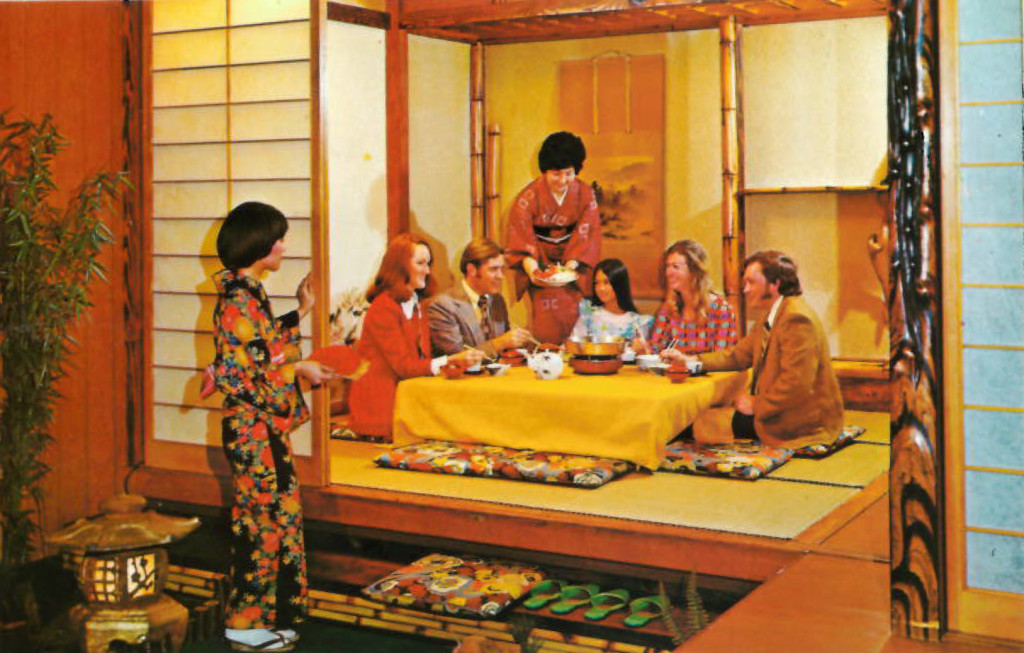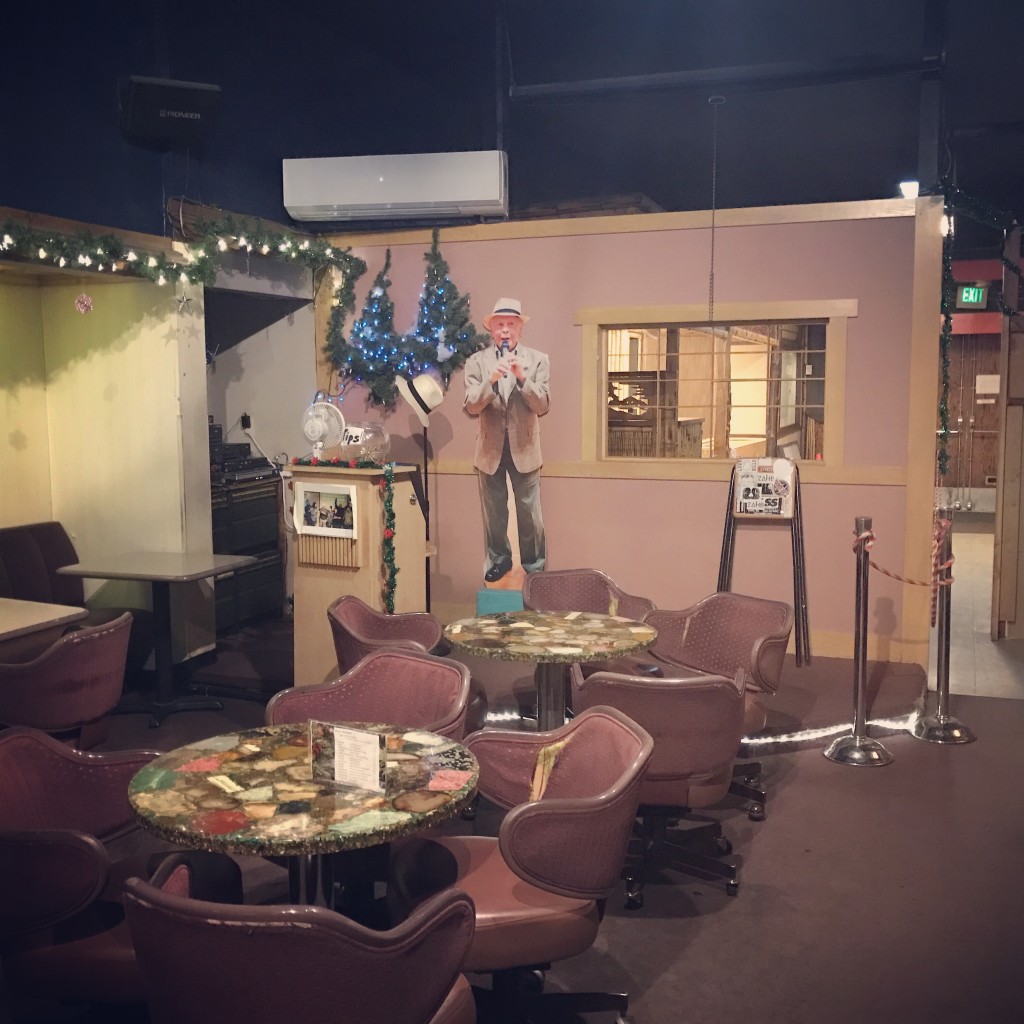Bush Garden, the Japanese restaurant and karaoke lounge located in the International District, is one of Seattle’s most venerable watering holes. Its doors have been open since 1953, but like many longtime, slightly seedy Seattle institutions in recent years, they might not be much longer.
The building that hosts the bar was purchased by Solterra, a Seattle and Portland residential developer, in January. It’s not clear whether the building will be razed or renovated, or when that might happen. Solterra has yet to make their plans known to the public or Bush Garden’s owners. What is clear is that, sometime in the near future, Bush Garden will no longer reside in the brownstone it has occupied since the ‘50s. Besides the immortal Maneki, Bush Garden is the oldest Japanese restaurant in town, and one of the city’s most beloved karaoke institutions.
Rumors about the bar’s imminent closure have circulated in the neighborhood off and on over the years. So regulars and neighbors weren’t completely surprised when word got out earlier this year that the bar would close for good in October.
The closure didn’t happen, due to the bar’s owner — Karen Akada Sakata —negotiating an indefinite extension to her lease that kept the bar open but ended lunch and dinner services. Sakata has worked at the restaurant off and on since the late ‘60s, and considers it vitally important to the neighborhood. But its future is uncertain — their lease is month to month, all she could get from the new owners was a verbal agreement to give two months notice.
According to Sakata, Bush Garden became the first karaoke bar in town in the ‘70s, when the owners started hosting Japanese karaoke. When Sakata started playing American songs in the bar in the late ‘80s, she might have become the person who introduced English language karaoke to Seattle.
But Bush Garden is much more than a karaoke lounge. Its true value lies in its community legacy. The bar’s racially integrated crowd and political clientele are unique in Seattle’s bar scene, and it is a longtime touchstone for Seattle’s Japanese American community.

Back when Sakata started at the restaurant, Bush was one of the fanciest restaurants in town. Its tatami rooms hosted countless martini-soaked business meetings. Families wearing their Sunday’s best, celebrating anniversaries and graduations, filled its giant banquet room. Dozens of weddings and wedding receptions have been held there.
For a few generations of Seattle-area Japanese Americans, Bush Garden was a demonstration of achievement. During World War II, Seattle’s Japanese American residents were cleared out of their segregated neighborhoods on First Hill and in Chinatown, and locked up in internment camps. After the war ended, the creation or re-creation businesses like Bush Garden and Uwajimaya showed the community’s resilience. Though their property and businesses were stolen by neighbors and speculators, Seattle’s Japanese folks came back. They demonstrated that Japanese Americans couldn’t and wouldn’t be removed by racism and hysteria, and that Asians were just as able as any other American to run a successful business and enter the middle class.
Bush is no longer a center of that community. The end of redlining means that Seattle’s Japanese community has spread throughout the region. What’s more, Japanese cuisine is no longer as hard to come by as it once was. Plenty of places now make more modern and formal versions of it than Bush Garden. The bar is now much more blue jean than black tie.
There is an upside to that change: Bush Garden is where everyone in the city can make themselves at home. It’s old and funky, but not divey. Everyone is nice, but the drinks are cheap and strong. People clap after every song. Nobody heckles the singers. The karaoke books aren’t alphabetized, but they do have a certain internal logic. Shōji panels overhang the vinyl-upholstered, mirrored booths. And, every night, a racially diverse bar crowd mixes in a low-key way.
Waves of hipsters occasionally dominate the karaoke microphone, belting out ironic versions of Tom Jones, but they don’t suck up the whole room. You can’t be too cool for Bush Garden, or not cool enough. It’s just been around for too long for anyone who goes there often to care.
“You can be the crew who comes in here every month and takes over,” says Allen Huang, a music booker who hosted karaoke at the bar once a week for six years. He’s also works with API Food Fight Club, an activist group that advocates for social justice in the International District. “But that’s not gonna get you anywhere. It’s funny, there’s people who come in from out of town and feel at home here. You can become family here.”
Maybe that’s why the bar is also home to a political legacy. City Council staffers knock back drinks shoulder to shoulder with anarchist activists and neighborhood seniors. King County Executive Dow Constantine came in a fair bit before he ran for office. “I've seen him in there like three or four times,” says Huang. “I don’t remember him singing, but he strikes me as a Journey type—maybe ‘Lights’ rather than ‘Don't Stop Believing.’”

More importantly, Bob Santos was a permanent fixture of the lounge. Santos was considered Mayor of Chinatown by many of its residents, and a member of the locally famous Gang of Four. The Gang— which also consisted of King County Councilmember Larry Gossett, El Centro de la Raza founder Roberto Maestas, and United Indians of All Tribes Foundation founder Bernie Whitebear — rose to prominence in the 1970s by leading local communities of color in civil rights campaigns.
All of them became fixtures of local politics, and they frequently met at the bar for birthdays and bull sessions. Santos was the leader mayors would call on if they needed advice about Chinatown issues, or wanted support from the Asian American community for a new policy measure. Santos would hold those meetings with lawyers and City Hall staffers over Bush Garden’s lunchtime bento box special.
More memorably, Santos would sing warbling, heartfelt standards on Bush’s small stage every Tuesday. Those evenings were Santos’s office hours, when activists and politicos knew they could get Santos’ advice or ask for a favor. When Santos died, someone at Bush made a cardboard cutout of him singing in a Panama hat. It’s pasted on the karaoke stage’s wall, next to the laser disc machine.
Bush Garden is the rare manifestation of Seattle’s idealized, low-key self-image. Unlike most bars in the city, it could be filled mostly by people of color or white folks on any given evening. In a time when Comet Tavern — a once-cheap Capitol Hill institution — does much its trade in $6.00 drafts and $20.00 rye, Bush is the genuine, no-frills article.
Unlike most vanishing Seattle institutions, Bush has a reservoir of goodwill and political juice. But even if the bar survives by moving to a new location, its building and the neighborhood that contains it will change.
Seattle’s Chinatown is the only part of the downtown core that has yet to see major development, and won’t stay that way for long. Hyatt is developing a new, fourteen story hotel a few blocks away from Bush Garden. Rumors of other transactions have already been passed from stool to stool at Bush’s bar.
New building owners Solterra have an office above the bar, where employees are figuring out what to do with the property. Solterra didn’t want the restaurant, which used to be open for lunch and dinner, to operate during office hours. The building’s age and design also create difficult circumstances for its occupants. The restaurant and the developers share the bar’s bathroom on the first floor, and there’s only one electricity meter.
“The building was designed to be pretty much single use, not multiple businesses,” Sakata says.

Bush’s restaurant operations weren’t nearly as successful as the bar, and Sakata thinks that Solterra might be open to another restaurant tenant that could bring in more business. Still, a new restaurant tenant would find itself in the same limbo as the bar. The arrangement would be, by definition, temporary. It’s unlikely anyone would want to invest in new equipment, or a fresh buildout, just to have it all removed two months after completion.
Sakata is hopeful to find partners that would ride out the remainder of Bush Garden’s stay in the current location and relocate with her. But that’s a costly proposition that few restaurateurs are likely to want to take on.
Ironically, Sakata says that business has been pretty good since the closure scare in October. Patrons from all over town have come to pay their respects and belt out 4 Non Blondes’ “What’s Up” one more time (someone always sings that song at karaoke). Thursday, Friday, and Saturday nights are even more packed than they used to be. It even fills up on some Mondays and Tuesdays.
Whether they know it or not, those singers are part of a rich legacy of Seattle’s small city past. Maybe, if they’re diligent and careful, Bush Garden’s community of connected regulars can help the old bar hang on in the modern, growing city.
--
Correction: Following publication of this article, King County executive Dow Constantine has informed Crosscut that he is not, in fact, a Journey fan, and prefers singing the music of Cheap Trick. We regret the error.



